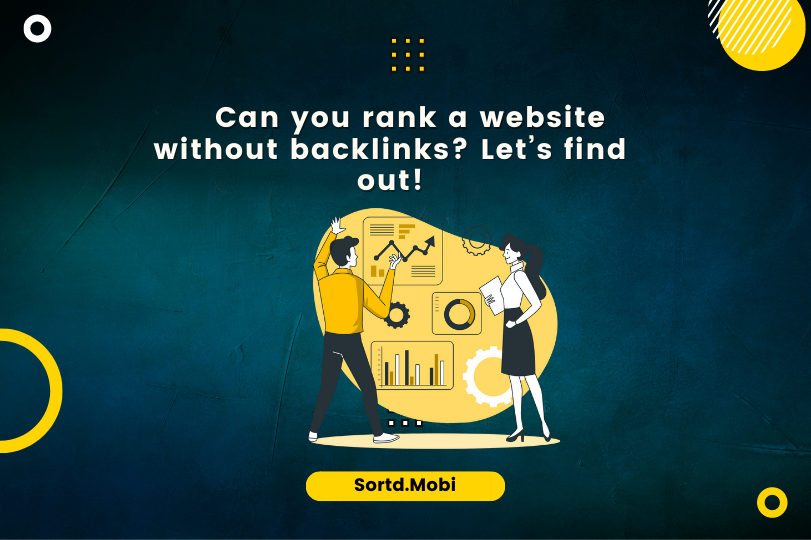Are you looking to rank a website without backlinks? Well, you need to have a strong backlink profile to rank well in search engine results pages (SERPs). However, many people think that your website can’t just rank without backlinks, but this is not true. Multiple factors are responsible for your website rank, and backlinks are one but not the only factor. In this blog, we will discuss alternative backlink options to push the website’s rank.
What are backlinks, and why are they crucial for SEO?
Keyword-optimised links, also known as backlinks, help your page rank algorithmically in SERPs. The more backlinks, the higher your chances are to rank well. With more quality backlinks from trusted websites, your chances of getting ranked on the first-page increase. Apart from backlinks, you need to look for the best ways to optimise your website for better ranking. A common mistake most website owners make is artificially generating backlinks. This may give short-term results, but your website may get penalised in the long run.
How to get your website ranked without backlinks?
Search engines recommend the best results to answer a search query. You can’t expect to get backlinks without creating the best content, but once you do, it will begin to appear in the search results. There are multiple ways to get backlinks, but in this blog, we will focus on creating the best content as a reverse engineering way to start the process of gaining backlinks over a period of time.
With the core focus on creating the best content without focusing on backlinks, here are the steps to create the best possible content.
1. Keyword Research
This is always one of the most critical steps in generating search engine traffic and serves as the base of your SEO strategy. You should look for phrases you want to rank based on the topics that reflect your industry, company, speciality, services, location, etc. From there, you should look at the details and ranking factors of the target keywords you want to rank.
Before you consider the keyword phrases, consider the intent, volume and keyword difficulty.
2. Research top 5 SERP Rankings
Once you have identified the keyword phrases, take some time to investigate the search results of the top 5 organic listings for your target keywords. You want to pay attention to the SERP results page, which includes the page title, meta description, and URL link. Also, research the main page headings (H1, H2, H3), links on the page for external and internal, word count, number of paragraphs, etc. Remember what we mentioned at the beginning of this blog—if you want to rank, focus on creating better content than the existing one. Get an idea of the content you need to focus on, the size of the content required and the graphics you may want to include in your content.
3. Build a framework and start creating content
This might sound like a simple step, but it is crucial. Start creating the outline of your article and start building the content. You can complicate this step further, but the key here is quality. High-quality content with the right keywords will help you get the ranking. Research a lot before writing to create a highly informative and unique content piece. Try to include pointers, a table of contents, article/blog outline to ensure a smooth reading experience. Not just a website, you need to focus on quality content even when you build apps for ios and android.
4. Optimise title tags, descriptions and on-page SEO
Once you have created the content, make sure you don’t forget to create the best title tag, social media image, meta description and your on-page SEO.
Regarding the title tag, the recommended length should not exceed 65 characters. Google has no clear definition for the size but keep in mind that SERPs show a limited amount of characters which can impact a user. For meta descriptions, you should ideally stick around 50-160 characters. We recommend including the primary phrase in your description.
Be sure to include keywords throughout your content but don’t overuse them. Include the main keyword in your H1 and the first paragraph of your content piece. Also, add alt tags in your images as this will describe them for search engines. Make sure you use the right keywords in the anchor text.
Additional tips for improving your website ranking
1. Improve the technical SEO of your website
Maintaining an error-free and easy-to-crawl website is one of the most crucial ranking factors. Google identifies the best content and experience for the search engine results pages. If your site structure is fragmented, has slow page speed, has broken links, is not mobile-friendly, etc., it can harm your SEO performance. You should run a website audit to check the potential errors and work towards fixing them.
2. Improve your internal linking
Identify keywords that exist on your current site pages and blog posts. To build up your internal linking strategy, you can use those as anchor text. When you insert keywords in specific blogs or web pages, this signals to Google what that particular page is all about.
3. Leverage social media
Posting the content of your website across various social media channels can help your content reach more people and create backlinks. If the right audience sees the content, it can build awareness.
How to track and monitor SEO?
Having a few SEO tools is recommended. It isn’t easy to monitor your SEO efforts without some support. Some important factors to monitor include organic traffic, link building, keyword ranking positions, top queries, site audit reports, top pages, and more.
There are tons of tools available online such as SEM Rush. You can make use of such tools to enhance your SEO activities. Opt for progressive web app development to target mobile users.


